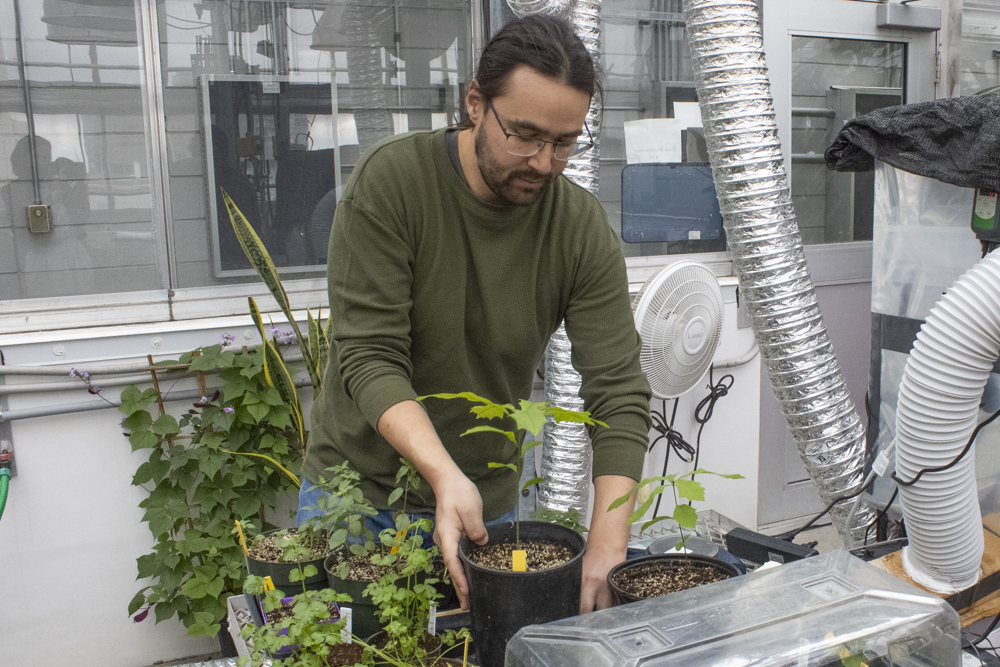Iowa was once 70 percent natural tallgrass prairie, housing native plant species like purple coneflower, butterfly milkweed, and
big bluestem.
Today, however, less than 0.1 percent of those prairies remain. This drastic decrease is unmistakably due to urban and agricultural development, including expansions of roads and the use of herbicides, according to the Iowa Prairie Network.
Fred Meyer, a master gardener and University of Iowa professor, said over the last three decades, more people have shifted from just planting ornamentals for the sake of beauty to planting them with the diversity of species in mind.
“We know there’s a problem, and we want to do something about it,” he said. “[We] are trying to improve our local ecosystems and trying to understand how they function so that their landscapes can contribute to
their functioning.”
Meyer, who has been gardening for decades, said working with native plants in his gardens has more benefits because of their developed synergistic interconnections with each other that allow them to thrive in his soil.
“Because [these native plants] have been here for thousands of years, they have adapted to our climate,” Meyer said. “They know what pollinators are around and what predators are after them.”
As a result, native plants are easier for Meyer and other Iowa gardeners to maintain.
Additionally, the yield of native plants is drastically more environmentally beneficial than non-native species.
“A non-native that you would get at a local nursery may produce a lot of flowers, but the flowers may not have as much nectar or pollen as its native counterpart would,”
Meyer said.
In 2006, Meyer founded Backyard Abundance, an environmental educational nonprofit organization dedicated to educating people in Iowa City about environmentally beneficial landscapes.
These landscapes, Meyer says, thrive on native vegetation. These plants play an integral role in our ecosystem as the primary diet of Iowa’s native animals. Without them, wildlife cannot survive. But this domino effect starts small.
Meyer recalled a recurring situation many years ago when he found himself amazed by the sheer number of bugs on his car windshield appearing in the morning — so many that they obstructed his view.
However, in recent years, his insect problem has greatly dropped, according to the Iowa Sierra Club. Though once an irritant, the loss of insects underscores their environmental necessity.
“[Insects] provide all these ecological functions. Without them, we eventually will suffer because there won’t be as many birds,” Meyer said. “If there aren’t as many birds, they’re not spreading seeds and they’re not doing their ecosystem functions.”
Cindy Parsons, the co-president of Project Green, a volunteer nonprofit organization in Johnson County, emphasized that more native species must be grown to attract more pollinators.
“If we had all of those [non-native plants], there just wouldn’t be much wildlife variety,” she said.
According to the National Park Service, pollinators can be anything that helps carry pollen from the male part of a flower to the female part of another or the same flower to ensure plant fertilization. This ensures the production of fruits, seeds, and baby plants.
Lucas Beilby, the co-president of a UI gardening club, D.I.R.T, noted the university’s efforts toward prairie restoration projects, which are only sometimes achievable for individuals with limited space.
Beilby is an avid supporter of gardening with native plants. According to him, incorporating native species into both landscaping and gardening can prevent the spread of harmful invasive species.
Invasive plant species, including Yellow Starthistle, Oriental Bittersweet, Dame’s
Rocket, and more, have the power to disrupt symbiotic — mutually beneficial — species relationships by proliferating into areas they weren’t meant to access.
Because native plants have already adapted to their habitat, they do not need fertilizers or many pesticides, according to the Environmental Protection Agency, some of which contain carcinogens.
Parsons said instead of going for the manicured, botanical garden look, there is a shift to planting that mimics what naturally grows in nature.
“One of the examples is by Iowa Avenue right by Gilbert Street. Tyler Baird, the superintendent of forestry in the Iowa City Parks and Recreation department, experimented with taking out some of the planted non-native species and put in the [natural plantings] of all sorts of native species,” she said.
By studying the roots of our environment, not only can we keep it beautiful, but also help it flourish for many more years to come.
Meyer also mentioned how humans tend to want to grow more of their own food during times of societal disturbance and said this was especially prevalent during the COVID-19 pandemic.
“During [the pandemic], people weren’t sure where their food was coming from. People tend to fall back into the landscape,” he said.
According to the Mayo Clinic, gardening increases exercise, reduces stress levels, and increases time spent in nature. This is no surprise, considering that it can feel gratifying to look after, plant, and harvest a garden.
“When we need to relax or rejuvenate, we go to the gardens,” Meyer said. “It’s just instinctual within us. We don’t always consciously know it, but we do feel
it subconsciously.”



